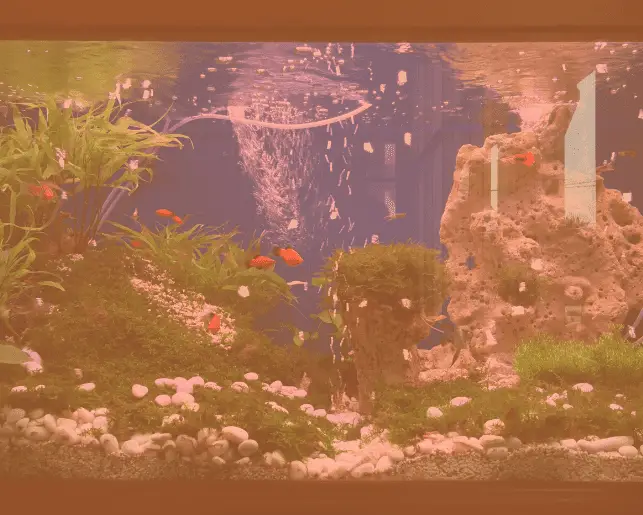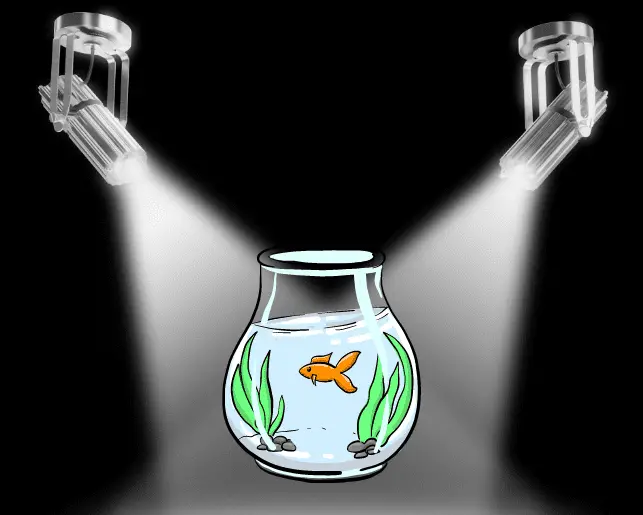Fish tank water is usually colourless and clear, but sometimes it can become tinted or cloudy. The orange colour in your fish tank water does not necessarily indicate a problem. However, it is critical to investigate and correct any issues to ensure your fish are safe.
Your fish tank water is orange due to high iron content or tannins leaching from driftwood. The particles collect under the gravel at the bottom of your tank and contribute to the growth of orange algae. It is common for the algae to grow in a newly installed tank six weeks after setting it up.
This article will find out the causes of orange algae and ways to remove it and keep it out of your fish tank. Let’s get started!
Why Does Orange Algae Grow in My Fish Tank?

Orange Algae grows in your fish tank due to the environmental conditions of the tank. Algae thrive in an environment rich in nutrients, light, and water, making a fish tank the perfect breeding ground.
Causes of algae in fish tanks include:
- Too much light
- Excess nutrients
- Not changing the water regularly enough
In the following sections, I will discuss each of these causes in detail.
Too Much Light.

Sunlight, LED lights and fluorescent light promote the growth of orange algae. While all light sources enhance algae breeding, LED lights cause the most algae multiplication and are the most popular since they are affordable. Therefore, it’s best to avoid overexposing your fish tank to natural or artificial light for long periods.
Excess Nutrients.
Orange algae grow rapidly in the presence of excess nutrients and minerals. These nutrients are in the following substances:
- Leftover fish food
- Dead fish
- Rocks and corals
- Phosphates from tap water
Avoid overfeeding the fish, remove food leftovers immediately, and use rocks and corals in moderation to prevent the growth of orange algae in the tank.
Not Changing the Water Regularly Enough.
It is critical to regularly change your fish tank water to help eliminate remnants of fish food. Also, phosphates and calcium build-up in water creates a rich breeding ground for algae. If your tap water is rich in phosphate or magnesium, consider filling the tank with distilled or reverse osmosis water instead.
Is Orange Algae Dangerous?
Orange algae is not dangerous to your fish unless it grows in excess. It is an aquatic plant whose forms, shapes and sizes enhance the aesthetics of the aquarium. Also, during respiration, algae intake carbon dioxide and release oxygen that helps to maintain pH levels in the fish tank.
However, unrestricted growth of algae can affect your fish and the fish tank in several ways.
- Respiration: Without sunlight or artificial light, respiration in algae is similar to that of animals. It uses oxygen and emits carbon dioxide. The result is a rise in the pH level in the water, making it acidic and uninhabitable for fish.
- Decomposition: Dead algae decomposes inside the fish tank and uses up oxygen. In turn, the shortage or lack of oxygen causes the death of the fish in the tank.
- Muddy-looking water: Excess algae makes the water look dirty and ruins the beauty of the fish tank. Cleaning the tank requires significant energy and time to maintain its beauty and the health of your fish.
How To Get Rid of Orange Algae in a Fish Tank.
Orange algae grows rapidly and can be challenging to remove. If left unattended, it can ruin the ecosystem in your fish tank. However, with proper care, you can maintain the health of your aquarium.
Here is how you can get rid of orange algae in your fish tank:
- Give it time.
- Clean the tank.
- Introduce algae eaters.
- Use a chemical algae remover.
The following sections will explain these steps and outline how to execute each one.
1. Give It Time
Orange algae occur naturally in about six weeks in a newly set up fish tank, as the tank establishes its nitrogen and bacteria cycle. It should clear on its own as the cycle stabilises. Also, plants in a new tank grow slower and absorb fewer nutrients than those in an older tank.
2. Clean the Tank
The most effective way to remove orange algae is to clean the tank manually. Use scrapers to scrape off the tank walls and sponges to wipe them off.
Clean the leaves and stems of your aquatic plants thoroughly. Also, remove and clean all your tank decorations.
You can use a 5 – 10% bleach solution to soak the plants and decorations to destroy the algae. Soak them in water to neutralise the bleach and rinse them thoroughly before placing them back because bleach is harmful to fish.
3. Introduce Algae Eaters
Algae eaters are an appealing, chemical-free way to remove orange algae from your fish tank, especially if you have non-aggressive fish and a freshwater tank. Algae eating shrimp, snails, and fish all have unique habitat requirements. Therefore, you need to pick what is compatible with your tank or adjust your tank conditions accordingly.
The Flying Fox is a prolific algae eater and is good for a community tank. You can read an article I have written about them here.
It is advisable not to add algae eaters to your new fish tank too soon. Wait until the conditions in the tank are established, and the algae is more obvious.
4. Use a Chemical Algae Remover
If all other methods fail and your tank still has excess algae, you can treat it using chemicals to kill the algae and inhibit future growth.
- Drain the tank completely and clean all the surfaces
- Refill the tank with clean water
- Add the chemical algae remover.
You can get the chemical pellets from your local fish shop, or from Amazon here. They are necessary because some algae may remain even after draining your fish tank.
How To Prevent Orange Algae.
All fish tanks have some algae, and it’s often nearly impossible to eliminate. However, there are ways to control the growth of orange algae in your fish tank.
- Check the tank’s placement. Position your fish tank away from the windows to reduce direct sunlight. Minimise your lighting intensity if it is artificial, and only leave the lights on for 8 – 10 hours each day.
- Watch out for excess food. Excess food, minerals, and nutrients stimulate the growth of orange algae. Generally, if the fish do not finish the food within five minutes, the portion size is excessive and you need to reduce it.
- Change the water. With time, phosphate and nitrate accumulate and promote algae growth. While you should not change all the water in the tank at once, changing up to 50% per week keeps nutrient levels balanced.
- Test the water. Check the pH, mineral, and nutrient levels in your fish tank and make the necessary changes. A new tank requires frequent testing, while an old tank can have regular tests to maintain a healthy system.
- Add live plants. Aquatic plants consume the same nutrients as algae, meaning fewer nutrients for the algae. About 25% of the fish tank’s ecosystem should be live plants to change the water quality.
- Invest in a water filter. You have to take extreme measures to combat algae growth if it persists through water changes. Do not underestimate your tank’s filtration requirements. Get a filtration system that is approximately one and a half times or double the size of the fish tank.
- Consider algae eaters. Some aquarium animals eat the algae and inhibit their multiplication. Before purchasing them, ensure their needs are compatible with your fish.
- Use chemicals. Algaecides and other chemicals, such as copper sulphate, prevent algae breeding. However, it is best to use them in moderation because they can harm or kill your fish.
Conclusion.
Orange algae in a fish tank is inevitable, but you can keep it under control with proper preparation.
The best way to prevent excess orange algae growth is to properly maintain your tank. You can do this by changing the tank’s water frequently, introducing plant life, and monitoring the amount of light the tank is exposed to each day.
Related Articles:
Why is my fish tank water GREEN?

